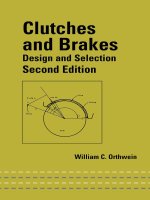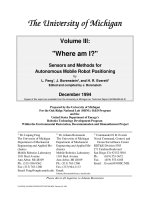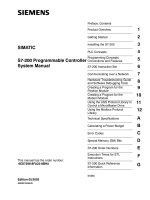Tài liệu Mathematics and Its History, Third Edition potx
Bạn đang xem bản rút gọn của tài liệu. Xem và tải ngay bản đầy đủ của tài liệu tại đây (5.66 MB, 683 trang )
Undergraduate Texts in Mathematics
Editorial Board
S. Axler
K.A. Ribet
For other titles published in this series, go to
/>
John Stillwell
Mathematics
and Its History
Third Edition
123
John Stillwell
Department of Mathematics
University of San Francisco
San Francisco, CA 94117-1080
USA
Editorial Board
S. Axler
Mathematics Department
San Francisco State University
San Francisco, CA 94132
USA
K.A. Ribet
Mathematics Department
University of California at Berkeley
Berkeley, CA 94720-3840
USA
ISSN 0172-6056
ISBN 978-1-4419-6052-8 e-ISBN 978-1-4419-6053-5
DOI 10.1007/978-1-4419-6053-5
Springer New York Dordrecht Heidelberg London
Library of Congress Control Number: 2010931243
Mathematics Subject Classification (2010): 01-xx, 01Axx
c
Springer Science+Business Media, LLC 2010
All rights reserved. This work may not be translated or copied in whole or in part without the written
permission of the publisher (Springer Science+Business Media, LLC, 233 Spring Street, New York,
NY 10013, USA), except for brief excerpts in connection with reviews or scholarly analysis. Use in
connection with any form of information storage and retrieval, electronic adaptation, computer soft-
ware, or by similar or dissimilar methodology now known or hereafter developed is forbidden.
The use in this publication of trade names, trademarks, service marks, and similar terms, even if they
are not identified as such, is not to be taken as an expression of opinion as to whether or not they are
subject to proprietary rights.
Printed on acid-free paper
Springer is part of Springer Science+Business Media (www.springer.com)
To Elaine, Michael, and Robert
Preface to the Third Edition
The aim of this book, announced in the first edition, is to give a bird’s-
eye view of undergraduate mathematics and a glimpse of wider horizons.
The second edition aimed to broaden this view by including new chapters
on number theory and algebra, and to engage readers better by including
many more exercises. This third (and possibly last) edition aims to increase
breadth and depth, but also cohesion, by connecting topics that were previ-
ously strangers to each other, such as projective geometry and finite groups,
and analysis and combinatorics.
There are two new chapters, on simple groups and combinatorics, and
several new sections in old chapters. The new sections fill gaps and update
areas where there has been recent progress, such as the Poincar´e conjec-
ture. The simple groups chapter includes some material on Lie groups,
thus redressing one of the omissions I regretted in the first edition of this
book. The coverage of group theory has now grown from 17 pages and 10
exercises in the first edition to 61 pages and 85 exercises in this one. As in
the second edition, exercises often amount to proofs of big theorems, bro-
ken down into small steps. In this way we are able to cover some famous
theorems, such as the Brouwer fixed point theorem and the simplicity of
A
5
, that would otherwise consume too much space.
Each chapter now begins with a “Preview” intended to orient the reader
with motivation, an outline of its contents and, where relevant, connections
to chapters that come before and after. I hope this will assist readers who
like to have an overview before plunging into the details, and also instruc-
tors looking for a path through the book that is short enough for a one-
semester course. Many different paths exist, at many different levels. Up
to Chapter 10, the level should be comfortable for most junior or senior
undergraduates; after that, the topics become more challenging, but also of
greater current interest.
vii
viii Preface to the Third Edition
All the figures have now been converted to electronic form, which has
enabled me to reduce some that were excessively large, and hence mitigate
the bloating that tends to occur in new editions.
Some of the new material on mechanics in Section 13.2 originally ap-
peared (in Italian) in a chapter I wrote for Volume II of
La Matematica
,
edited by Claudio Bartocci and Piergiorgio Odifreddi (Einaudi, Torino,
2008). Likewise, the new Section 8.6 contains material that appeared in
my book The Four Pillars of Geometry (Springer, 2005).
Finally, there are many improvements and corrections suggested to me
by readers. Special thanks go to France Dacar, Didier Henrion, David
Kramer, Nat Kuhn, Tristan Needham, Peter Ross, John Snygg, Paul Stan-
ford, Roland van der Veen, and Hung-Hsi Wu for these, and to my son
Robert and my wife, Elaine, for their tireless proofreading.
I also thank the University of San Francisco for giving me the opportu-
nity to teach the courses on which much of this book is based, and Monash
University for the use of their facilities while revising it.
John Stillwell
Monash University and the University of San Francisco
March 2010
Preface to the Second Edition
This edition has been completely retyped in L
A
T
E
X, and many of the figures
redone using the PSTricks package, to improve accuracy and make revision
easier in the future. In the process, several substantial additions have been
made.
• There are three new chapters, on Chinese and Indian number theory,
on hypercomplex numbers, and on algebraic number theory. These
fill some gaps in the first edition and give more insight into later
developments.
• There are many more exercises. This, I hope, corrects a weakness of
the first edition, which had too few exercises, and some that were too
hard. Some of the monster exercises in the first edition, such as the
one in Section 2.2 comparing volume and surface area of the icosa-
hedron and dodecahedron, have now been broken into manageable
parts. Nevertheless, there are still a few challenging questions for
those who want them.
• Commentary has been added to the exercises to explain how they
relate to the preceding section, and also (when relevant) how they
foreshadow later topics.
• The index has been given extra structure to make searching easier.
To find Euler’s work on Fermat’s last theorem, for example, one no
longer has to look at 41 different pages under “Euler.” Instead, one
can find the entry “Euler, and Fermat’s last theorem” in the index.
• The bibliography has been redone, giving more complete publica-
tion data for many works previously listed with little or none. I have
found the online catalogue of the Burndy Library of the Dibner In-
stitute at MIT helpful in finding this information, particularly for
ix
x Preface to the Second Edition
early printed works. For recent works I have made extensive use of
MathSciNet, the online version of Mathematical Reviews.
There are also many small changes, some prompted by recent mathe-
matical events, such as the proof of Fermat’s last theorem. (Fortunately,
this one did not force a major rewrite, because the background theory of
elliptic curves was covered in the first edition.)
I thank the many friends, colleagues, and reviewers who drew my at-
tention to faults in the first edition, and helped me in the process of revision.
Special thanks go to the following people.
• My sons, Michael and Robert, who did most of the typing, and my
wife, Elaine, who did a great deal of the proofreading.
• My students in Math 310 at the University of San Francisco, who
tried out many of the exercises, and to Tristan Needham, who invited
me to USF in the first place.
• Mark Aarons, David Cox, Duane DeTemple, Wes Hughes, Christine
Muldoon, Martin Muldoon, and Abe Shenitzer, for corrections and
suggestions.
John Stillwell
Monash University
Victoria, Australia
2001
Preface to the First Edition
One of the disappointments experienced by most mathematics students is
that they never get a course on mathematics. They get courses in calculus,
algebra, topology, and so on, but the division of labor in teaching seems to
prevent these different topics from being combined into a whole. In fact,
some of the most important and natural questions are stifled because they
fall on the wrong side of topic boundary lines. Algebraists do not discuss
the fundamental theorem of algebra because “that’s analysis” and analysts
do not discuss Riemann surfaces because “that’s topology,” for example.
Thus if students are to feel they really know mathematics by the time they
graduate, there is a need to unify the subject.
This book aims to give a unified view of undergraduate mathematics by
approaching the subject through its history. Since readers should have had
some mathematical experience, certain basics are assumed and the mathe-
matics is not developed formally as in a standard text. On the other hand,
the mathematics is pursued more thoroughly than in most general histories
of mathematics, because mathematics is our main goal and history only
the means of approaching it. Readers are assumed to know basic calcu-
lus, algebra, and geometry, to understand the language of set theory, and to
have met some more advanced topics such as group theory, topology, and
differential equations. I have tried to pick out the dominant themes of this
body of mathematics, and to weave them together as strongly as possible
by tracing their historical development.
In doing so, I have also tried to tie up some traditional loose ends. For
example, undergraduates can solve quadratic equations. Why not cubics?
They can integrate 1/
√
1 − x
2
but are told not to worry about 1/
√
1 − x
4
.
Why? Pursuing the history of these questions turns out to be very fruitful,
leading to a deeper understanding of complex analysis and algebraic ge-
ometry, among other things. Thus I hope that the book will be not only a
xi
xii Preface to the First Edition
bird’s-eye view of undergraduate mathematics but also a glimpse of wider
horizons.
Some historians of mathematics may object to my anachronistic use of
modern notation and (fairly) modern interpretations of classical mathemat-
ics. This has certain risks, such as making the mathematics look simpler
than it really was in its time, but the risk of obscuring ideas by cumber-
some, unfamiliar notation is greater, in my opinion. Indeed, it is practically
a truism that mathematical ideas generally arise before there is notation or
language to express them clearly, and that ideas are implicit before they
become explicit. Thus the historian, who is presumably trying to be both
clear and explicit, often has no choice but to be anachronistic when tracing
the origins of ideas.
Mathematicians may object to my choice of topics, since a book of
this size is necessarily incomplete. My preference has been for topics with
elementary roots and strong interconnections. The major themes are the
concepts of number and space: their initial separation in Greek mathemat-
ics, their union in the geometry of Fermat and Descartes, and the fruits
of this union in calculus and analytic geometry. Certain important topics
of today, such as Lie groups and functional analysis, are omitted on the
grounds of their comparative remoteness from elementary roots. Others,
such as probability theory, are mentioned only briefly, as most of their de-
velopment seems to have occurred outside the mainstream. For any other
omissions or slights I can only plead personal taste and a desire to keep the
book within the bounds of a one- or two-semester course.
The book has grown from notes for a course given to senior undergrad-
uates at Monash University over the past few years. The course was of
half-semester length and a little over half the book was covered (Chapters
1–11 one year and Chapters 5–15 another year). Naturally I will be de-
lighted if other universities decide to base a course on the book. There is
plenty of scope for custom course design by varying the periods or topics
discussed. However, the book should serve equally well as general reading
for the student or professional mathematician.
Biographical notes have been inserted at the end of each chapter, partly
to add human interest but also to help trace the transmission of ideas from
one mathematician to another. These notes have been distilled mainly from
secondary sources, the Dictionary of Scientific Biography (DSB) normally
being used in addition to the sources cited explicitly. I have followed the
DSB’s practice of describing the subject’s mother by her maiden name.
Preface to the First Edition xiii
References are cited in the name (year) form, for example, Newton (1687)
refers to the Principia, and the references are collected at the end of the
book.
The manuscript has been read carefully and critically by John Crossley,
Jeremy Gray, George Odifreddi, and Abe Shenitzer. Their comments have
resulted in innumerable improvements, and any flaws remaining may be
due to my failure to follow all their advice. To them, and to Anne-Marie
Vandenberg for her usual excellent typing, I offer my sincere thanks.
John Stillwell
Monash University
Victoria, Australia
1989
Contents
Preface to the Third Edition vii
Preface to the Second Edition ix
Preface to the First Edition xi
1 The Theorem of Pythagoras 1
1.1 Arithmetic and Geometry 2
1.2 Pythagorean Triples 4
1.3 Rational Points on the Circle 6
1.4 Right-Angled Triangles 9
1.5 Irrational Numbers 11
1.6 The Definition of Distance 13
1.7 Biographical Notes: Pythagoras 15
2 Greek Geometry 17
2.1 The Deductive Method 18
2.2 The Regular Polyhedra 20
2.3 Ruler and Compass Constructions 25
2.4 Conic Sections 28
2.5 Higher-Degree Curves 31
2.6 Biographical Notes: Euclid 35
3 Greek Number Theory 37
3.1 The Role of Number Theory 38
3.2 Polygonal, Prime, and Perfect Numbers 38
3.3 The Euclidean Algorithm 41
3.4 Pell’s Equation 44
3.5 The Chord and Tangent Methods 48
xv
xvi Contents
3.6 Biographical Notes: Diophantus 50
4 Infinity in Greek Mathematics 53
4.1 Fear of Infinity 54
4.2 Eudoxus’s Theory of Proportions 56
4.3 The Method of Exhaustion 58
4.4 The Area of a Parabolic Segment 63
4.5 Biographical Notes: Archimedes 66
5 Number Theory in Asia 69
5.1 The Euclidean Algorithm 70
5.2 The Chinese Remainder Theorem 71
5.3 Linear Diophantine Equations 74
5.4 Pell’s Equation in Brahmagupta 75
5.5 Pell’s Equation in Bhˆaskara II 78
5.6 Rational Triangles 81
5.7 Biographical Notes: Brahmagupta and Bhˆaskara 84
6 Polynomial Equations 87
6.1 Algebra 88
6.2 Linear Equations and Elimination 89
6.3 Quadratic Equations 92
6.4 Quadratic Irrationals 95
6.5 The Solution of the Cubic 97
6.6 Angle Division 99
6.7 Higher-Degree Equations 101
6.8 Biographical Notes: Tartaglia, Cardano, and Vi`ete 103
7 Analytic Geometry 109
7.1 Steps Toward Analytic Geometry 110
7.2 Fermat and Descartes 111
7.3 Algebraic Curves 112
7.4 Newton’s Classification of Cubics 115
7.5 Construction of Equations, B´ezout’s Theorem 118
7.6 The Arithmetization of Geometry 120
7.7 Biographical Notes: Descartes 122
Contents xvii
8 Projective Geometry 127
8.1 Perspective 128
8.2 Anamorphosis 131
8.3 Desargues’s Projective Geometry 132
8.4 The Projective View of Curves 136
8.5 The Projective Plane 141
8.6 The Projective Line 144
8.7 Homogeneous Coordinates 147
8.8 Pascal’s Theorem 150
8.9 Biographical Notes: Desargues and Pascal 153
9Calculus 157
9.1 What Is Calculus? 158
9.2 Early Results on Areas and Volumes 159
9.3 Maxima, Minima, and Tangents 162
9.4 The Arithmetica Infinitorum of Wallis 164
9.5 Newton’s Calculus of Series 167
9.6 The Calculus of Leibniz 170
9.7 Biographical Notes: Wallis, Newton, and Leibniz 172
10 Infinite Series 181
10.1 Early Results 182
10.2 Power Series 185
10.3 An Interpolation on Interpolation 188
10.4 Summation of Series 189
10.5 Fractional Power Series 191
10.6 Generating Functions 192
10.7 The Zeta Function 195
10.8 Biographical Notes: Gregory and Euler 197
11 The Number Theory Revival 203
11.1 Between Diophantus and Fermat 204
11.2 Fermat’s Little Theorem 207
11.3 Fermat’s Last Theorem 210
11.4 Rational Right-Angled Triangles 211
11.5 Rational Points on Cubics of Genus 0 215
11.6 Rational Points on Cubics of Genus 1 218
11.7 Biographical Notes: Fermat 222
xviii Contents
12 Elliptic Functions 225
12.1 Elliptic and Circular Functions 226
12.2 Parameterization of Cubic Curves 226
12.3 Elliptic Integrals 228
12.4 Doubling the Arc of the Lemniscate 230
12.5 General Addition Theorems 232
12.6 Elliptic Functions 234
12.7 A Postscript on the Lemniscate 236
12.8 Biographical Notes: Abel and Jacobi 237
13 Mechanics 243
13.1 Mechanics Before Calculus 244
13.2 The Fundamental Theorem of Motion 246
13.3 Kepler’s Laws and the Inverse Square Law 249
13.4 Celestial Mechanics 253
13.5 Mechanical Curves 255
13.6 The Vibrating String 261
13.7 Hydrodynamics 265
13.8 Biographical Notes: The Bernoullis 267
14 Complex Numbers in Algebra 275
14.1 Impossible Numbers 276
14.2 Quadratic Equations 276
14.3 Cubic Equations 277
14.4 Wallis’s Attempt at Geometric Representation 279
14.5 Angle Division 281
14.6 The Fundamental Theorem of Algebra 285
14.7 The Proofs of d’Alembert and Gauss 287
14.8 Biographical Notes: d’Alembert 291
15 Complex Numbers and Curves 295
15.1 Roots and Intersections 296
15.2 The Complex Projective Line 298
15.3 Branch Points 301
15.4 Topology of Complex Projective Curves 304
15.5 Biographical Notes: Riemann 308
Contents xix
16 Complex Numbers and Functions 313
16.1 Complex Functions 314
16.2 Conformal Mapping 318
16.3 Cauchy’s Theorem 319
16.4 Double Periodicity of Elliptic Functions 322
16.5 Elliptic Curves 325
16.6 Uniformization 329
16.7 Biographical Notes: Lagrange and Cauchy 331
17 Differential Geometry 335
17.1 Transcendental Curves 336
17.2 Curvature of Plane Curves 340
17.3 Curvature of Surfaces 343
17.4 Surfaces of Constant Curvature 344
17.5 Geodesics 346
17.6 The Gauss–Bonnet Theorem 348
17.7 Biographical Notes: Harriot and Gauss 352
18 Non-Euclidean Geometry 359
18.1 The Parallel Axiom 360
18.2 Spherical Geometry 363
18.3 Geometry of Bolyai and Lobachevsky 365
18.4 Beltrami’s Projective Model 366
18.5 Beltrami’s Conformal Models 369
18.6 The Complex Interpretations 374
18.7 Biographical Notes: Bolyai and Lobachevsky 378
19 Group Theory 383
19.1 The Group Concept 384
19.2 Subgroups and Quotients 387
19.3 Permutations and Theory of Equations 389
19.4 Permutation Groups 393
19.5 Polyhedral Groups 395
19.6 Groups and Geometries 398
19.7 Combinatorial Group Theory 401
19.8 Finite Simple Groups 404
19.9 Biographical Notes: Galois 409
xx Contents
20 Hypercomplex Numbers 415
20.1 Complex Numbers in Hindsight 416
20.2 The Arithmetic of Pairs 417
20.3 Properties of + and × 419
20.4 Arithmetic of Triples and Quadruples 421
20.5 Quaternions, Geometry, and Physics 424
20.6 Octonions 428
20.7 Why C, H,andO Are Special 430
20.8 Biographical Notes: Hamilton 433
21 Algebraic Number Theory 439
21.1 Algebraic Numbers 440
21.2 Gaussian Integers 442
21.3 Algebraic Integers 445
21.4 Ideals 448
21.5 Ideal Factorization 452
21.6 Sums of Squares Revisited 454
21.7 Rings and Fields 457
21.8 Biographical Notes: Dedekind, Hilbert, and Noether 459
22 Topology 467
22.1 Geometry and Topology 468
22.2 Polyhedron Formulas of Descartes and Euler 469
22.3 The Classification of Surfaces 471
22.4 Descartes and Gauss–Bonnet 474
22.5 Euler Characteristic and Curvature 477
22.6 Surfaces and Planes 479
22.7 The Fundamental Group 484
22.8 The Poincar´e Conjecture 486
22.9 Biographical Notes: Poincar´e 492
23 Simple Groups 495
23.1 Finite Simple Groups and Finite Fields 496
23.2 The Mathieu Groups 498
23.3 Continuous Groups 501
23.4 Simplicity of SO(3) 505
23.5 Simple Lie Groups and Lie Algebras 509
23.6 Finite Simple Groups Revisited 513
23.7 The Monster 515
Contents xxi
23.8 Biographical Notes: Lie, Killing, and Cartan 518
24 Sets, Logic, and Computation 525
24.1 Sets 526
24.2 Ordinals 528
24.3 Measure 531
24.4 Axiom of Choice and Large Cardinals 534
24.5 The Diagonal Argument 536
24.6 Computability 538
24.7 Logic and G¨odel’s Theorem 541
24.8 Provability and Truth 546
24.9 Biographical Notes: G¨odel 549
25 Combinatorics 553
25.1 What Is Combinatorics? 554
25.2 The Pigeonhole Principle 557
25.3 Analysis and Combinatorics 560
25.4 Graph Theory 563
25.5 Nonplanar Graphs 567
25.6 The K˝onig Infinity Lemma 571
25.7 Ramsey Theory 575
25.8 Hard Theorems of Combinatorics 580
25.9 Biographical Notes: Erd˝os 584
Bibliography 589
Index 629
1
The Theorem of Pythagoras
Preview
The Pythagorean theorem is the most appropriate starting point for a book
on mathematics and its history. It is not only the oldest mathematical the-
orem, but also the source of three great streams of mathematical thought:
numbers, geometry, and infinity.
The number stream begins with Pythagorean triples; triples of integers
(a, b, c) such that a
2
+ b
2
= c
2
. The geometry stream begins with the
interpretation of a
2
, b
2
,andc
2
as squares on the sides of a right-angled
triangle with sides a, b, and hypotenuse c. The infinity stream begins with
the discovery that
√
2, the hypotenuse of the right-angled triangle whose
other sides are of length 1, is an irrational number.
These three streams are followed separately through Greek mathemat-
ics in Chapters 2, 3, and 4. The geometry stream resurfaces in Chapter
7, where it takes an algebraic turn. The basis of algebraic geometry is
the possibility of describing points by numbers—their coordinates—and
describing each curve by an equation satisfied by the coordinates of its
points.
This fusion of numbers with geometry is briefly explored at the end of
this chapter, where we use the formula a
2
+ b
2
= c
2
to define the concept
of distance in terms of coordinates.
J. Stillwell, Mathematics and Its History, Undergraduate Texts in Mathematics, 1
DOI 10.1007/978-1-4419-6053-5
1,
c
Springer Science+Business Media, LLC 2010
2 1 The Theorem of Pythagoras
1.1 Arithmetic and Geometry
If there is one theorem that is known to all mathematically educated people,
it is surely the theorem of Pythagoras. It will be recalled as a property of
right-angled triangles: the square of the hypotenuse equals the sum of the
squares of the other two sides (Figure 1.1). The “sum” is of course the sum
of areas and the area of a square of side l is l
2
, which is why we call it “l
squared.” Thus the Pythagorean theorem can also be expressed by
a
2
+ b
2
= c
2
, (1)
where a, b, c are the lengths shown in Figure 1.1.
a
b
c
Figure 1.1: The Pythagorean theorem
Conversely, a solution of (1) by positive numbers a, b, c can be re-
alized by a right-angled triangle with sides a, b and hypotenuse c.Itis
clear that we can draw perpendicular sides a, b for any given positive num-
bers a, b, and then the hypotenuse c must be a solution of (1) to satisfy
the Pythagorean theorem. This converse view of the theorem becomes
interesting when we notice that (1) has some very simple solutions. For
example,
(a, b, c) = (3, 4, 5), (3
2
+ 4
2
= 9 + 16 = 25 = 5
2
),
(a, b, c) = (5, 12, 13), (5
2
+ 12
2
= 25 + 144 = 169 = 13
2
).
It is thought that in ancient times such solutions may have been used for
the construction of right angles. For example, by stretching a closed rope
with 12 equally spaced knots one can obtain a (3, 4, 5) triangle with right
angle between the sides 3, 4, as seen in Figure 1.2.









